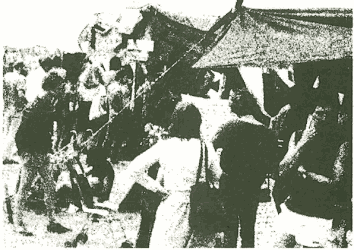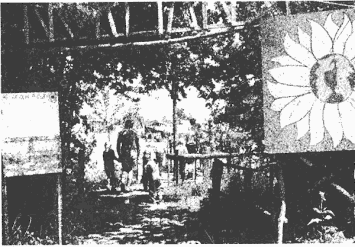I can’t quite remember why it was me – perhaps everyone else was already too busy – but I took on the job as the Green Collective’s site co-ordinator for the first Green Field at Glastonbury Festival. A little while before, we’d had a meeting in Glastonbury itself, when we had created the rudiments of a site plan in a way that I’ve never forgotten. We sat in a circle with eyes closed, maybe twenty of us, whilst Lorye led us through a visualisation with her shamanic drum. She kept up a regular heart-beat rhythm whilst she asked us first to look down at our feet, then to walk forward and into the field.

The drum kept beating steadily as we walked around and noted what we could see there. I don’t know how long this took – it may have been ten minutes or maybe half an hour – until we all came back to our bodies and opened our eyes, still sitting in our circle. Then we went round one by one, each of us describing what we had seen.
Everyone had seen something different, though the extraordinary thing was that it all fitted together, nothing seemed to exclude anything else, and so by this means we accessed from the right half of our brains a collective image of what the Green Field should look like.
Once on site we set about creating it as best as we could. That year we were in Norman’s Close, in the field next to the Theatre Field. Uphill was Cock Mill Meadow which had recently been used for a scout camp; straw bales and useful bits of wood were scattered all over the place and we started by collecting these up. The Meadow was to become a car park so we built a little footbridge over a stream, providing friendly pedestrian access. The site was planned out based around the tipi circle and a small market area – genuinely green stallholders could have a pitch in the Green Field at Green Gathering prices rather than Festival prices. The tipi circle did not have many tipis, though the open space in the centre of the field was very important and carefully protected from campers arriving after dark. The totem pole was brought over from Lamberts Hill where it had been created in 1983 and though it nearly came crashing down during the process of erection, all was well in the end.

Our main objective was to create an atmosphere that people would notice as soon as they entered the Field. This was successful and for me the key, as I later noted, was that we managed to generate a sense of common identity and community, by putting ‘personal inter-relationships and community spirit before ideology, even before programmes and strategies; putting feelings before ideas’. Physically, the field was kept litter-free and cared for. The entrance at the bottom of the field, which had been badly cut up by cattle in wet mud that had since dried hard, was covered on each side with pallets and on top of them were placed grow-bags planted up with pansies that had been recycled after use in corporation flower beds. This was thanks to Katie Stanley, and it was something that got carried through to later Green Fields and in 1986 was even tried in an effort to mellow out the centre of the main festival site.
Whilst all this was coming together the Green Field site crew grew gradually larger as more and more people turned up. Some were unexpected but we didn’t turn anyone away; there was no fixed limit to the amount of work to do. Whole families arrived, with their children, and we were clearly beginning to put an unexpected strain on Charlie Wrighton’s Goose Hall site kitchen. Eating at Goose Hall already meant running the gamut of ribald comments from the regular site crew, who mostly looked like steel fixers with wide leather belts hung with wire cutters and hammers. ‘We’re going to build a tower so we can climb up and watch the mating habits of the greens’, stuff like that. One morning we arrived to be served ‘green semolina’ for breakfast, a slimy sort of porridge coloured with spirulina. ‘We thought you greens would like that’. The crunch came with the announcement that there would be no food for children, only workers.
We all walked out. Back in the Green Field we pooled our resources and a couple of people drove off to Shepton to buy in provisions. By the end of the day we had our own makeshift site kitchen and we never went back to Goose Hall. So far as I know it was the first separate area catering operation at Glastonbury Festival, and the precedent made it easier for the Green Field to establish itself the following year at the furthest end of the site.
All this required us having control of the gate into Cockmill Lane so that getting in and out was easy, as was letting in our friends when they arrived. I was in charge of the key, with strict instructions not to let it out of my sight. One day a JCB came steaming up the lane and it stopped outside the gate. I went to see what was happening and the driver asked me to unlock the gate. In came the JCB, then five minutes later it wanted to go back out and I had to stop work again to open and close the gate. After this had happened a couple of times the driver said that he’d have to be coming and going quite a lot and maybe I could leave the key under a stone just inside the gate, so that he could reach it without disturbing me all the time. This seemed like a sensible idea so I left the key under a stone and went back to work.
Next thing Andrew Kerr, overall Site Manager and next in the festival hierarchy below Michael Eavis himself, appeared with the key in his hand and told me I was a security risk and the greens could no longer have their own access to the gate. I had been deliberately set up. I was absolutely livid and as soon as Andrew had gone I stormed out of the field, up across the site, through the farmyard, into the farmhouse and into Michael’s office. I was carried along on a wave of fury that got me there without stopping and without anything slowing me down for so much as a single second. I arrived and ranted at Michael, who calmly told me that he’d get it sorted out and not to worry – which sure enough he did. The experience taught me something important about the clean use of righteous anger. It was a very long time, though, before I felt able to make friends with Andrew Kerr.
By the end of all this I’d decided, ‘Never again!’ All the same the experiment of bringing our youthful exuberance and idealism – not to mention our naivite – into the midst of a heavy duty rock festival, was by no means a failure. What was described as the ‘almost tangible atmosphere of harmony and peace’ together with our ‘workshops, exhibitions, tents, solar showers, windmills, healing sessions and all manner of colorful events’ was not just appreciated – it proved to be durable. The Green Fields are still there, and give Glastonbury something that other rock festivals simply do not have. This, I like to feel, all had its roots in that sunny afternoon when we sat in a circle and visioned our way into the Green Field of our collective and active imagination. 1984 was something very special.
The Green Collective did not long survive the transition, though perhaps that’s just as well – those of us involved are left with our vivid memories and the satisfaction of knowing that others stepped in to take up our ideas in the more difficult times ahead. At the 1984 Green Field I took part in my first sweat lodge. In the warm, sweaty atmosphere I watched awestruck as the glowing stones were carried in and the door flap closed and secured to keep out the light. The only visible thing was the deep red glow of the rocks in the centre of the circle, and I knew that people had seen this sight, and felt much the same, since the stone age. Timeless magic, that’s what my memories conjure up for me. It’s something that can never altogether disappear.
